Related Research Articles
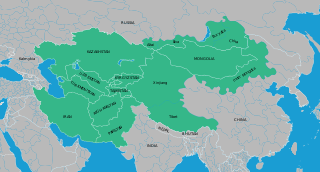
Inner Asia refers to the northern and landlocked regions spanning North, Central and East Asia. It includes parts of western and northeast China, as well as southern Siberia. The area overlaps with some definitions of 'Central Asia', mostly the historical ones, but certain regions that are often included in Inner Asia, such as Manchuria, are not a part of Central Asia by any of its definitions. Inner Asia may be regarded as the western and northern "frontier" of China proper of the former Qin dynasty and as being bounded by East Asia proper, which consists of China proper, Japan and Korea.

Beshbalik is an ancient Turkic archaeological site, now located in Jimsar County, Changji Hui Autonomous Prefecture, Xinjiang, China. The ancient city was initially called Beiting or Ting Prefecture, and was the headquarters of the Beiting Protectorate during the 8th century. It was later known as Beshbalik and became one of the capitals of the Uyghur Khaganate and then the Kingdom of Qocho.

Peter Benjamin Golden is an American historian who is "professor emeritus" of History, Turkish and Middle Eastern Studies at Rutgers University. He has written many books and articles on Turkic and Central Asian studies, such as An introduction to the history of the Turkic peoples.

Jimsar County is a county in Changji Hui Autonomous Prefecture, Xinjiang, China. It contains an area of 8,149 km2 (3,146 sq mi). According to the 2002 census, it has a population of 130,000.
The Kangly were a Turkic people of Eurasia who were active from the Tang dynasty up to the Mongol Empire and Yuan dynasty.
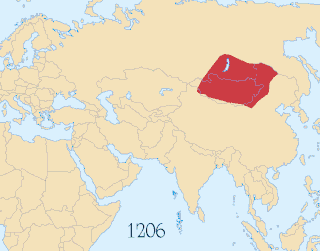
This is the timeline of the Mongol Empire from the birth of Temüjin, later Genghis Khan, to the ascension of Kublai Khan as emperor of the Yuan dynasty in 1271, though the title of Khagan continued to be used by the Yuan rulers into the Northern Yuan dynasty, a far less powerful successor entity, until 1634.
Denis Sinor was a Distinguished Professor Emeritus of Central Asian Studies at the Department of Central Eurasian Studies at Indiana University and a tenured lecturer at Cambridge University between 1948 and 1962, and was one of the world's leading scholars for the history of Central Asia. Under his directorship, the Central Asian Studies at Indiana University became one of the world's foremost centers for Central Asian history, languages and linguistics.

The Ganzhou Uyghur Kingdom, also referred to as the Hexi Uyghurs, was established in 894 around Ganzhou in modern Zhangye. The kingdom lasted from 894 to 1036; during that time, many of Ganzhou's residents converted to Buddhism.
The siege of Lüshun was a military conflict between the Later Jin and Ming dynasty. In the summer of 1634 the Jin attacked and conquered the port city of Lüshun from Ming.
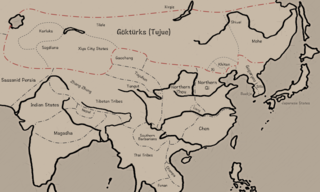
This is a timeline of the Göktürks from the origins of the Turkic Khaganate to the end of the Second Turkic Khaganate.

This is a timeline of the Karluks. The Kara-Khanid Khanate is also included; however, it is disputed whether the Karluks or Yagmas were the dominant group within the khanate.
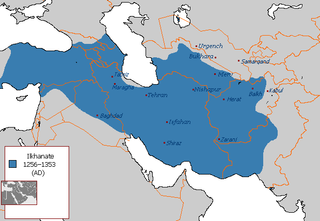
This is a timeline of the Ilkhanate.

This is a timeline of the Chagatai Khanate (1226–1348) and its successor states, Moghulistan (1347–1462), Yarkent Khanate (1514–1696), and the Turpan Khanate (1462–1680).
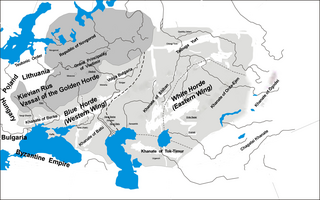
This is a timeline of events involving the Golden Horde (1242–1502), from 1459 also known as the Great Horde.

Yunnan under Ming rule saw the continuation of the tusi system instituted during the Yuan dynasty, increasing centralization, and Han migration into Yunnan.

This is a timeline of the Qing dynasty (1636–1912).

The Jurchen unification were a series of events in the late 16th and early 17th centuries that led to the unification of the Jurchen tribes under Nurhaci, a Jianzhou Jurchen leader who had an antagonistic relationship with the Ming dynasty due to their involvement in events early on in his life that led to the death of his father and grandfather. From 1583 to the early 1600s, Nurhaci led a series of military and influence campaigns that led to the unification of the majority of the Jurchen tribes. In 1616, Nurhaci established the Later Jin dynasty and ruled as its founding khan.

This is a timeline of the Xinjiang under the rule of the Qing dynasty.
The siege of Bukhara took place in February 1220, during the Mongol conquest of the Khwarazmian Empire. Genghis Khan, ruler of the Mongol Empire, had launched a multi-pronged assault on the Khwarazmian Empire ruled by Shah Muhammad II. While the Shah planned to defend his major cities individually, the Mongols laid siege to the border town of Otrar and struck further into Khwarazmia.
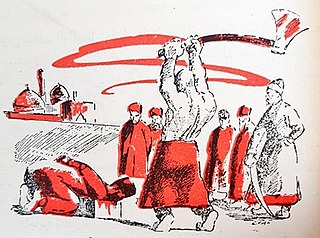
The siege of Gurganj took place during the Mongol conquest of the Khwarazmian Empire. Genghis Khan, ruler of the Mongol Empire, had launched a multi-pronged assault on the Khwarazmian Empire, ruled by Shah Muhammad II. Through a combination of efficient planning and excellent manoeuvering, the Khan's army managed to take the border town of Otrar swiftly, followed by the large cities of Bukhara and Samarkand.
References
- ↑ Franke, Herbert. "The Cambridge History of Early Inner Asia edited by Denis Sinor". Histories.cambridge.org. Retrieved 24 October 2016.
- ↑ "The Cambridge History of Inner Asia | Regional and World History General Interest | Cambridge University Press". Cambridge.org. 27 May 2015. Retrieved 24 October 2016.
- ↑ "Robert Crews | Stanford Department of History". history.stanford.edu. Archived from the original on 2 June 2012. Retrieved 17 January 2022.
- ↑ "Annette Bohr". Chatham House. 11 March 2014. Retrieved 24 October 2016.